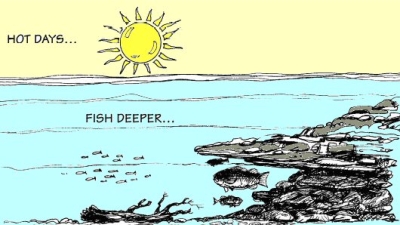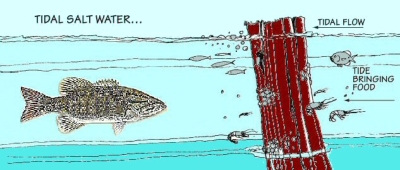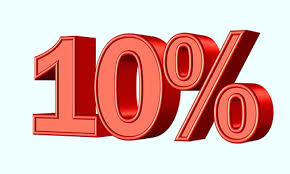When Is The Best Time To Fish - "Anytime you can get on the water”
The best time to go fishing is dawn and dusk, in the early morning, or at night if you have the right equipment. Fish bite the most when it's cool, and when they haven't been feeding all day. The tides, pressures, weather, and natural events are all included when picking the best day to fish.If you go for a saltwater fishing off of a dock, beach or jetties for snapper, Steelhead Trout, redfish or Fluke; or a freshwater River Fishing for Pike, Carp, Lake Fishing or pond fishing for Largemouth Bass or Crappie. Always check changing tides, time of day, wind, storm and weather patterns, water conditions, the amount of sunlight, warming trends, and depth at which fish can be. Don’t forget to look for the most promising locations and then look for the signs that indicate the presence of feeding fish. When to fish is also affected by Where To Fish.
The weather and the moon have as much to do with fishing as any two factors, and understanding how is the key to knowing when the best time of day is for fishing. When a frontal system passes through the area that you are going to be fishing, the barometric pressure either rises or falls. When the pressure moves one way or the other fish can detect this change through their lateral lines. Depending on whether the pressure is rising or falling (generally rising is good, falling is bad) the fish will feed accordingly. The moon is also a big factor in whether or not fish are feeding. Depending on what phase the moon is in, fish will also be more or less active which means they will be biting or not biting. The moon plays a major role in the best time to fish. For example, fishing is much better during a new moon phase than it is during a waning crescent. The bottom line is that the moon is a determining factor in the best time to be fishing.
When it's very warm and sunny, fish move to more comfortable cooler, deeper waters to stay calm. Cloudy days are great for fishing because the clouds cover sunlight. Water temperature controls the fish’s body temperature and some functions including how much and when to eat. Morning sun warms the shallows, which creates comfortable water temperatures for fish to feed. Late morning is the best time to fish.
Fish habits changes during day time. In the early morning and late afternoon, cooler temperatures and lower light levels allow fish to swim in shallow water for meals. Warm fronts cause surface water temperatures to increase, fishing increase near the warm surface. Fishing will be slow during and after a storm or cold front.
The best conditions are during a rising or falling tide, when water is moving your bait will move and provoke active feeding among coastal fish. If you go for a Freshwater fishing the best is a season at spawning time because fish bite better if they have an annual vacation. In summer, the catch drops off when adult fish change their diet from elusive one-year-olds to easy-to-catch newborns. With full bellies and plenty more where that came from, they are not much interested in hunting around for plugs, spoons and spinners. In fall, the angler's luck improves as the surviving little fish grow larger and harder for the big fish to catch. By winter, the fishing should be even better. But with cold weather, a fishes digestion slows down; it takes 350 hours to digest the same minnow it would digest in several summer hours.
These "best times" can be related to the amount of sunlight, to warming trends, to depth at which fish are found, to storm and weather patterns, to wind, and to tidal flows when saltwater fishing.
All fish are cold-blooded. Fish can’t maintain their body temperature at a constant level as other warm-blooded animals do. The temperature of the surroundings influences the fish’s body temperature and bodily functions – including how much and when to eat. Lower water temperatures slow fish body movements and decrease food intake. Understanding these biological functions allows adjusting lures and baits with slower (cold water) or faster (warmer water) retrieves.
Different conditions are often related. Many freshwater fish such as bass are most active during the early morning and late evening hours. Fish find the reduced light levels during these times more comfortable than the bright sun of midday. Less turbulent waters (less wind) in lakes and ponds during those hours also allow fish to cruise the shallows searching for food on or near the surface.
Spring Fishing
Once the ice is out, the water on the surface of a lake starts to warm. There's spring turnover exchange of surface and bottom water in a lake or pond. Warmer water goes from the top of the lake to the bottom and cooler water moves from the bottom to the top. Fish will stay in the shallow areas of the lake where the water warms up faster, and where the first plant growth of the spring occurs.Early Morning – The winter is over and fish are hungry and spawning. The water is still cold and doesn't heat up because the sun is low and the rays bounce off the water. Bad time for fishing, the water temperature must be higher.
Late Morning-Early Afternoon – Sun rays begin to penetrate the water and the water starts to warm up. Wind start pushing the warmer water with the food, so you need to fish the downwind shoreline.
Afternoon-Early Evening – Sun heated the water and fish start eating a lot because their metabolism and digestion are cranked.
Summer Fishing
During the summer, the sun heats water near the surface of lakes, putting a well-defined warm layer of water over a cool one. Fish like the cooler water, but they also need the higher oxygen levels found in warmer water. So they'll migrate to an area right between the two levels of water warm and cold. This level can be between 2 and 10 ft in depth, depending on the size of the lake. It's best to find a point or some other form of structure that extends out from the shoreline and slopes gradually down into the thermo cline. This should be a place where fish can find warmer water, but have quick access to deeper, cooler and safer water.Early Morning-Late Afternoon - Fishing is excellent from before sunup to just before mid-morning. At this time of year there is a lot of food and cover for fish, so to find hungry fish is difficult.
Late Morning-Early Afternoon – Water is worm. Fish move to deeper water to cool off. Fishing is very poor for most of the day.
Afternoon-Early Evening - The waters is cool and fish rise up from the depths. Fishing is great from early sundown until dark.
Fall Fishing
With the arrival of fall and cooler air temperatures, water at the surface of lakes cools, becoming almost as heavy as the cooler bottom water. Strong autumn winds move surface water around, which promotes mixing with deeper water. This is fall turnover. As mixing continues, lake water becomes more uniform in temperature and oxygen level, allowing fish to move around freely. Fish can be difficult to find as long as these conditions prevail, usually continues until the weather turns cold, chilling the lake's surface.Early Morning - The sun is too low to penetrate the cold water. There is no baiting much from sunup to early morning.
Late Morning-Noon - The water is generally cool due to the season. Fishing is very pure in warmer, shallow water.
Afternoon-Early Evening - Sun is directly overhead for several hours and the water gets very warm near the surface. Fishing is excellent because fish are gaining weight prepare for the winter. Look for fish bait schools, the bigger fish will be there.
Back to top
Winter Fishing
Water temperature serves as the most critical element in locating and catching fish. Fish are cold blooded, during colder periods their metabolic rate slows way down and they eat less.On colder days, fish stay in the warmest water they can find, so try to locate deeper dredge holes, canals and pockets adjacent to shallow flats, and slow down your presentation to a crawl. The colder the water, the slower the retrieve.
The warmer the water in winter, the more chance you have at catching fish. Deeper water will be the best bet in early mornings and on sunny days the flats can come alive as those temperatures begin to rise.
The current which triggers fish feeding can come from the wind and from the tide. They love to take up a position on the down tide/wind side of a point that has the current sweeping across it.
During bouts of cold weather with sunny days, fish the flats late in the afternoon when the water has absorbed maximum radiation. Fish will move to the warmer water to feed. Areas of dark bottom can be especially productive late in the afternoon.
Cold water is extremely clear water. Use lighter fishing tackle, less visible in the water.
Fish respond to changes in atmospheric pressure. Cold fronts usher in high pressure shut down the fishing action completely.
Don’t let cold weather stop you from fishing.
How climate and temperature affects fishing?
| On inland lakes, water temperatures tend to settle into horizontal layers of warm water and cold water that are separated by a moderate layer known as the "thermocline", that are the most active "feeding zone". On larger bodies of water like the oceans, large masses of water temperature also have a moderating layer that is known as a "temperature break", that is the most active "feeding zone" in the ocean or large lakes. You can find some fish in the wormer top layer, the bottom colder part of the top layer and at varying depths within these active "feeding zones". |

|
Fish are cold blooded. In a very cold water fish will be dormant, sluggish and will not feed. In water too warm, they will look a more comfortable environment.
If fish likes cold water, most likely this fish will be on the surface in the fall and deep in the water in the spring. Warm water lovers will be on the surface in the summer and at the bottom in the fall.
All fish has different temperature ranges of where it is more comfortable to survive. Hot or cold water temperatures create a lock of oxygen in the water, which makes fish less active. Therefore fishing will slow down when water temperature is too high or too low.
Fishing will be slower when it's too hot or too cold.
Back to top
How amount of light influence fishing?
Usually early morning and evening are the best time for fish to feed in the hot zones. In the afternoon fish moves deeper in the water which makes deep fishing bites the best options for the midday.When it's warm and sunny, fish are usually going to move to cooler, deeper waters to stay comfortable. Cloudy days are usually good days to fish because the clouds diffuse the sunlight.
The morning sun warms shallow waters, which creates comfortable water temperatures for fish and makes them more active. Late morning is a great time for fishing.
In the early morning or late afternoon, cooler temperatures and lower light levels allow fish to lurk in the shallows for meals. Fish prefer early morning and evening sun to the bright sun of midday.
Back to top
How rain or winds influence the fishing?
Different weather conditions play a big role during fishing.Light rain washes insects into the water-more food for fish. For those who fish from the boat or from the shore, the light rain will make you more invisible for the fish.
Unfortunately, heavy rain is a bad time for fishing. It changes the water flow in rivers, creates uncomfortable situation for fish to keep its position and makes it very difficult to find bait.
Wind usually play important role in fishing success. During the windy weather food and a bait fish are carrying together with the current from the wind. The game fish is coming after the bait fish. On a windy day if fishing from offshore cast into the wind, if fishing from a boat, cast with the wind on a protected shoreline.
Storms affect the fishing success too. Fish is always looking for food before storm will come but not during or after the storm.
During the cold season fish is most likely to look for food after a warm front moves in. Fish is very active especially on or near warm surface. The cold front makes the water temperature to decrease and creates a poor fishing.
Clouds create a comfortable atmosphere for fishing. Clouds stop light penetration and make fish look more for food instead of hiding from bright sun.
Back to top
Role of Tides during saltwater fishing
| The rising or falling time is the best for fishing while water level is not too deep or too low. As a water level decreasing, fish sense the dropping water and will move out with the tide to deeper water. When water level increases, larger fish, such as redfish, flounder, drum and trout will also follow that rising tide. Tides cause bait to move and promote active feeding coastal fish. |

|
Tides are the periodic rise and fall of the ocean waters. They are caused by the gravitational pulls of the Moon and sun. In most areas tides occur twice per day and affects the fish location and feeding. The tides trigger most fish into becoming more active.
Not just changing tides, but also time of day and location are very important when you're fishing in brackish water—coastal water (a mix of salt and fresh water) and contains saltwater and freshwater fish.
Back to top


































